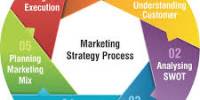Market segmentation means dividing a market into smaller groups of buyers with distinct needs, characteristics, or behaviors who might require separate products or marketing mixes. It splits up a market into different types (segments) to enable a business to better target its products to the relevant customers.
Through market segmentation, companies divide large heterogeneous markets into smaller segments that can be reached more efficiently and effectively with products and services that match their unique needs. The market is of two types, both of which can be segmented. They are:
- Consumer Market,
- Business Market
Consumer market segmentation
There no single way to segment a market. A marketer has to try different segmentation variables, alone and in combination. Following is the list of different variables for segmenting consumer markets:
- Geographic segmentation
- Demographic segmentation
- Psychographic segmentation
- Behavioral segmentation
(1) Geographic segmentation
Geographic segmentation calls for dividing the market different geographical units, such as nations, regions, states, countries or neighborhoods. A company may decide to operate in one or a few geographical areas, or to operate in all areas but pay attention to geographical differences in needs and wants.
(2) Demographic segmentation
Demographic segmentation divides the market into groups, based on variables such as age, gender, family size, family life cycle, occupation, education, religion, race 7 nationalities. Thus demographic segmentation to has its own variables such as Age, gender, family size, income, occupation, religion, race, and nationality. There are two reasons for demographic factors being the most popular bases for segmenting consumer market. First, consumer, needs, wants and usage rates often vary closely with demographic variables. Second, demographic variables are easy to measure than most other types of variables.
Bases for demographic segmentation are:
- Age and life cycle
- Gender
- Income
(3) Psychographic Segmentation
Psychographic segmentation is one which uses lifestyle of people, their activities, interests as well as opinions to define a market segment. Examining some psychographic attributes which influence buying decisions; marketers go for segmenting their consumer market. These psychographic attributes are:
- Social class: There exist different social classes in the society, like, upper class, middle class, working class and so on. They differ in their perceptions, likings, disliking.
- Personality: Consumers do not buy the same things in the same way because their personality plays an influential role in buying attitudes. Market segmentation may not be possible based on personality, but it is important in developing the promotional strategy.
- Lifestyle: Consumer’s lifestyle relates to activities, interests, and options which affects the products they buy and which brand they prefer.
(4) Behavioral Segmentation
This type of market segmentation divides the population on the basis of their behavior, usage and decision-making pattern. For example – young people will always prefer Dove as soap, whereas sports enthusiast will use Lifebuoy. Marketers regularly attempt to segment their markets on the basis of product-related behavior. These are:
- Occasions: Consumers attempt to purchase different products on different occasions.
- Benefits desired: Marketers segment buyers based on different benefits that they desire from the product.
- Usage rate: Segmenting markets based on the rate at which people use or consume a product. A frequently used categorization of usage rate is light users, medium users, heavy users.
- Loyalty status: Loyalty differs from consumer to consumer. Some are loyal to brands (lux, Cats eye, Pepsi), stores (Agora, Almas, Nandan, Big Bazaar), and companies (Square, Unilever).
Business market segmentation
Consumers and business marketers use many of the same variables to segment their markets. Business buyers can be segmented geographically, demographically (industry, company size), or by benefits sought. Business marketers also use some additional variables such as:
- Type of customers
- Size of customers
- Type of buying situation
Information Source:
















